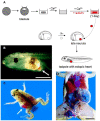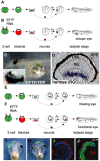Programming pluripotent precursor cells derived from Xenopus embryos to generate specific tissues and organs
- PMID: 24710095
- PMCID: PMC3966229
- DOI: 10.3390/genes1030413
Programming pluripotent precursor cells derived from Xenopus embryos to generate specific tissues and organs
Abstract
Xenopus embryos provide a rich source of pluripotent cells that can be differentiated into functional organs. Since the molecular principles of vertebrate organogenesis appear to be conserved between Xenopus and mammals, this system can provide useful guidelines for the directional manipulation of human embryonic stem cells. Pluripotent Xenopus cells can be easily isolated from the animal pole of blastula stage Xenopus embryos. These so called "animal cap" cells represent prospective ectodermal cells, but give rise to endodermal, mesodermal and neuro-ectodermal derivatives if treated with the appropriate factors. These factors include evolutionary conserved modulators of the key developmental signal transduction pathways that can be supplied either by mRNA microinjection or direct application of recombinant proteins. This relatively simple system has added to our understanding of pancreas, liver, kidney, eye and heart development. In particular, recent studies have used animal cap cells to generate ectopic eyes and hearts, setting the stage for future work aimed at programming pluripotent cells for regenerative medicine.
Figures



References
-
- Spemann H. Experimentelle Beiträge zu einer Theorie der Entwicklung. Springer; Berlin, Germany: 1936.
-
- Dale L., Slack J.M. Regional specification within the mesoderm of early embryos of Xenopus laevis. Development. 1987;100:279–295. - PubMed
LinkOut - more resources
Full Text Sources
Medical
Miscellaneous

